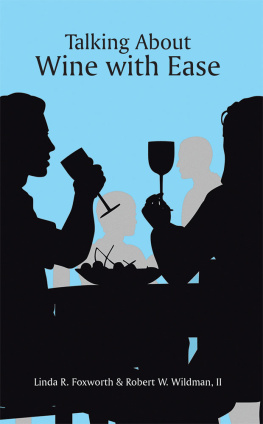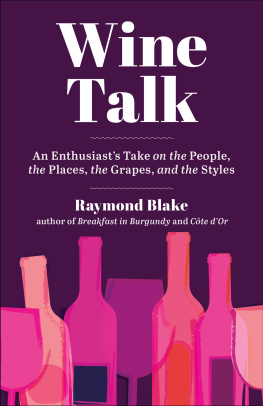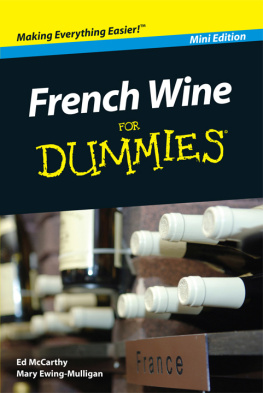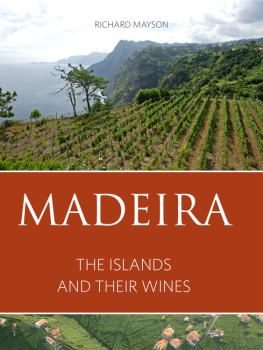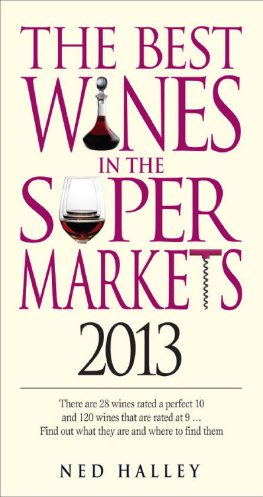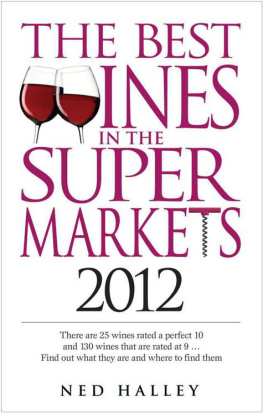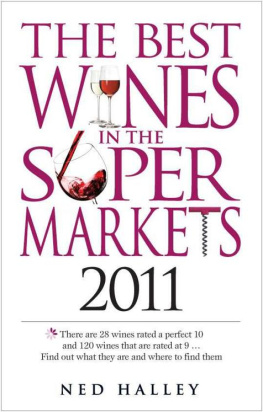Foxworth Linda R - Talking About Wine With Ease
Here you can read online Foxworth Linda R - Talking About Wine With Ease full text of the book (entire story) in english for free. Download pdf and epub, get meaning, cover and reviews about this ebook. year: 2015, publisher: Trafford Publishing;Foxworth, Linda R., Trafford on Demand Pub, Wildman, Robert W, genre: Romance novel. Description of the work, (preface) as well as reviews are available. Best literature library LitArk.com created for fans of good reading and offers a wide selection of genres:
Romance novel
Science fiction
Adventure
Detective
Science
History
Home and family
Prose
Art
Politics
Computer
Non-fiction
Religion
Business
Children
Humor
Choose a favorite category and find really read worthwhile books. Enjoy immersion in the world of imagination, feel the emotions of the characters or learn something new for yourself, make an fascinating discovery.
- Book:Talking About Wine With Ease
- Author:
- Publisher:Trafford Publishing;Foxworth, Linda R., Trafford on Demand Pub, Wildman, Robert W
- Genre:
- Year:2015
- Rating:3 / 5
- Favourites:Add to favourites
- Your mark:
- 60
- 1
- 2
- 3
- 4
- 5
Talking About Wine With Ease: summary, description and annotation
We offer to read an annotation, description, summary or preface (depends on what the author of the book "Talking About Wine With Ease" wrote himself). If you haven't found the necessary information about the book — write in the comments, we will try to find it.
Talking About Wine With Ease — read online for free the complete book (whole text) full work
Below is the text of the book, divided by pages. System saving the place of the last page read, allows you to conveniently read the book "Talking About Wine With Ease" online for free, without having to search again every time where you left off. Put a bookmark, and you can go to the page where you finished reading at any time.
Font size:
Interval:
Bookmark:
Talking About Wine with Ease
Linda R. Foxworth & Robert W. Wildman, II
Copyright 2015 Linda R. Foxworth & Robert W. Wildman, II.
All rights reserved. No part of this publication may be reproduced, stored in a retrieval system, or transmitted, in any form or by any means, electronic, mechanical, photocopying, recording, or otherwise, without the written prior permission of the author.
ISBN: 978-1-4907-5886-2 (sc)
ISBN: 978-1-4907-5887-9 (e)
Library of Congress Control Number: 2015906244
Because of the dynamic nature of the Internet, any web addresses or links contained in this book may have changed since publication and may no longer be valid. The views expressed in this work are solely those of the author and do not necessarily reflect the views of the publisher, and the publisher hereby disclaims any responsibility for them.
Any people depicted in stock imagery provided by Thinkstock are models,
and such images are being used for illustrative purposes only.
Certain stock imagery Thinkstock.
Trafford rev. 05/06/2015
 www.trafford.com
www.trafford.com
North America & international
toll-free: 1 888 232 4444 (USA & Canada)
fax: 812 355 4082
Contents
Talking About Wine wit h Ease
A brief summary of and guide to the world
of wine written for those wishing to quickly
learn to function in social and business settings
in which wines are served, discussed and
appreciated
Linda R. Foxworth, Certified Specialist o f Wine
Robert W. Wildman, II, Certified Specialist o f Wine
DEDICATIONS
For Dixie. Thank you for your encouragement, advice and wicked sense of humor.
Linda R. Fo xworth
This book is dedicated to my grandmother, Fay Keller Wildman Digby, who was ever grateful for wine in its Sacramental, as well as its other manifestations. I would also like to acknowledge the editorial and graphic design contributions of Linda D. Wi ldman.
Robert W. Wildm an, II
CHAPTER 1
INTRODUCTION AND WINE BASICS
Congratulations! You have achieved or are achieving a responsible position in life. You have important duties and a voice in organizational meetings. You are also asked to entertain colleagues, bosses and affluent clients.
Of course, youve been preparing yourself for this new role for years. You took the right courses to qualify for advancement in this industry. You also took such electives as art and music appreciation to make sure that you were ready for the social aspects of this job. But another part of this life, wine knowledge, has, in all probability, been so far left out of your education. After all, few of us grew up in an environment in which fine wines were routinely served and discussed. There are, for obvious reasons, no undergraduate survey courses on wine.
This little book seeks to remediate this small gap in your broadly-defined education. It is hoped that this brief resource, in conjunction with your own then more finely-tuned observations, will help you in rather immediately functioning successfully in the world of entertaining with wine.
Features of thi s Work
Pronunciation guide . To help you learn to rapidly function in this area, we are presenting a simplified guide to pronouncing wine-related terms which relies upon common English words and obvious nonsense syllables. For example, the best known wine producing area of France is Bordeaux. While an encyclopedia would guide you to say this name as bawr doh, we opt for the more intuitive bore dough. For the sake of brevity, each non-English word will be pronounced out only once, even if that same word recurs in subsequent names presented.
Talking points . These are standard, safe comments which are frequently used by people who are knowledgeable about wines. Employed cautiously, your saying them yourself makes you appear to be an insider in this area of study and jazzes up your conversations at social functions.
Things to remember . These are the primary pieces of information about each country/chapter which the authors believe should most definitely be remembered
Overview not a handbook . We hope you will find this little book worthy of being read in its entirety. For the sake of brevity, information presented in one chapter is not repeated in other chapters to which it is also relevant.
Maps . All outline maps in this publication were obtained from http://www.d-maps.com/ . Wine regions were added by authors and are approximate only.
Talking Points
- Isnt it fascinating that the French are so committed to the concept of terroir (tear whar), defined below, that they dont even have a word for winem aker ?
- Isnt it instructive that to produce great wines grapevines have to struggle for survival? Theyre sort of like people in that respect, dont you agree?
- Its so ironic that the great wines of Europe are made from grapes which get their nutrients through rootstocks from Texas!
 Six things to remember about wine:
Six things to remember about wine:
- The world of wine is divided into Old and New. Old World wine is wine that is made in the European countries of France, Italy, Spain, Portugal, Germany, Austria and other countries of Europe. New World wine is made outside of Europe in the countries of South Africa, Australia, New Zealand, Canada, United States, Argentina, Chile and other countries outside of E urope.
- Old World vineyards have cooler climates and thus produce more acidic wines. New World vineyards have warmer climates and thus produce more fruit-forward wines.
- Old World wines are named for the region in which they are produced, such as Bordeaux or Chianti. The New World wines are named for the grapes from which they are made, such as Cabernet Sauvignon or Sangi ovese.
- The Old World has strict laws regarding what grapes can be planted where. All red Burgundies must be made from Pinot Noir, or they cannot be called Burgundy. The New World has no such laws, and while some regions of the New World do quite well with a particular grape, such as Napa and Cabernet Sauvignon, the winemakers of the New World are free to grow any grapes they want and still put the name of the region on the bottle. In other words, the region of the New World will not tell you the grapes of the wine.
- There are seven noble grapes. The four red noble grapes are Cabernet Sauvignon, Merlot, Pinot Noir and Syrah. The three white noble grapes are Chardonnay, Sauvignon Blanc and Riesling. What makes these grapes stand out above all others, and there are thousands of others, is that they have a good sugar/acid balance, they have a consistent flavor profile, they produce wines with enough structure that they can age well, and they can be grown successfully in many parts of the world.
- When a wine is professionally evaluated, it is evaluated for both structure and aroma. The structure is made up of four elements: acidity, alcohol, tannins, if any, and residual sugar, if any. What is most important to the quality of the wine is that the elements are in balance with each other. We will discuss the typical aromas for each grape in chapter 16 of this book.
Grape Growing and Wine making
While the details of grape growing and winemaking are rarely discussed in social settings, there are a few basics which may come up and which you need to know.
Vitis vinifera grapes rule . Wine can be made from anything that contains sugar, like apples and peaches. But all of the great wines of the world are made from grapes, specifically from those of the species Vitis vinifera (vee tis ven if a rhaa), commonly called the European wine grape. Native American species, most usually Vitis labrusca (la brews caa), are still made into wine on the east coast, but they produce pungent wines, often characterized as foxy, which are not to the liking of those used to the European style of wine.
Next pageFont size:
Interval:
Bookmark:
Similar books «Talking About Wine With Ease»
Look at similar books to Talking About Wine With Ease. We have selected literature similar in name and meaning in the hope of providing readers with more options to find new, interesting, not yet read works.
Discussion, reviews of the book Talking About Wine With Ease and just readers' own opinions. Leave your comments, write what you think about the work, its meaning or the main characters. Specify what exactly you liked and what you didn't like, and why you think so.

